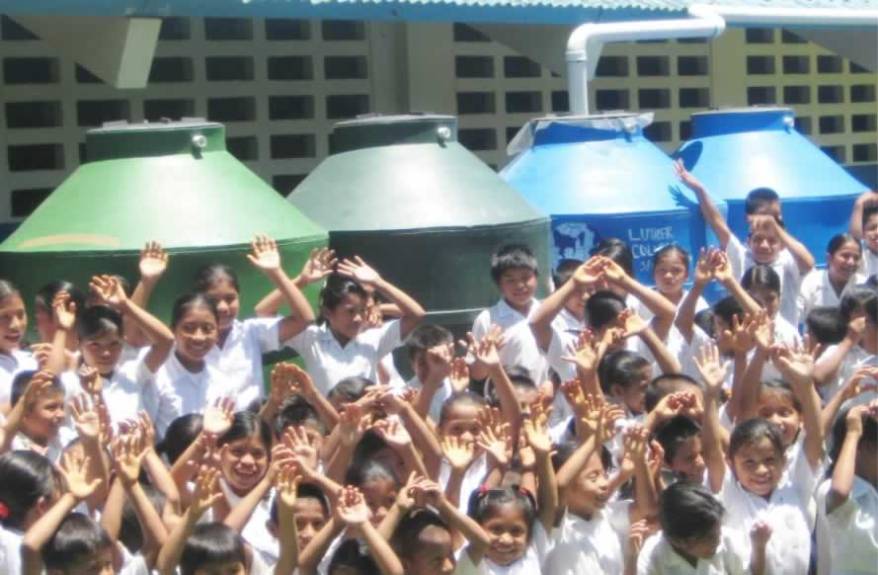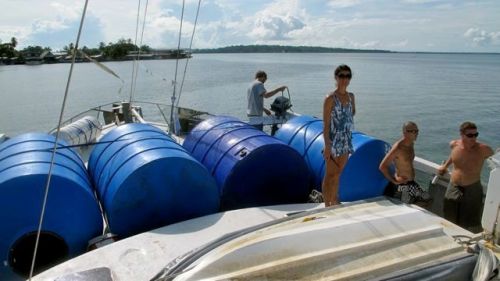Report urges world to secure drinking water access
U N s Green Economy report
By LOUISE NORDSTROM – Associated Press AP 26aug2011
STOCKHOLM (AP) — Investing as little as 0.16 percent of the world’s gross domestic product — or $198 billion per year — could give half a billion people regular access to safe drinking water within four years, a U.N. official said Friday.
That would halve the number of people who risk serious illness and death on a daily basis, the United Nations Environment Program said.
The findings are presented in the U.N.’s Green Economy report, which also warns that if the global community continues to ignore water services investments, demand for water risks outstripping supply by 40 percent before 2030.
UNEP spokesman Nick Nuttall said the world total of people without access to safe drinking water currently totals around 1 billion people.
According to the report, people living in countries such as Cambodia, Indonesia, the Philippines and Vietnam are particularly prone to catching waterborne diseases because of the poor water sanitation there.
“Accelerated investment in water-dependent ecosystems, water infrastructure and water management, coupled with effective policies, can boost water and food security, improve human health and promote economic growth,” said U.N. Under-Secretary-General and UNEP Executive Director Achim Steiner.
Prof. Mike Young, lead author of the water chapter of the report, said that “without this investment and policy reform, water supply crises will become increasingly common.”
UNEP said that more water productivity, recycling, new dams and desalination plants could largely help avoid increased drinking water scarcity but that money also needs to be put toward infrastructure, water policy reforms and technologies.
The findings were presented during this week’s World Water Week in Stockholm.
Its participants also signed a statement urging next year’s Earth Summit in Rio de Janeiro to commit to achieving “universal provisioning of safe drinking water, adequate sanitation and modern energy services by the year 2030.” That would include making water safer and more available, reducing water pollution, increasing the quantity of recycled water, and using water more efficiently in energy production, agriculture and the food supply chain.
Message from Blogger: Rainworks
SOLUTIONS:
Rain Water Harvesting (RWH): Benefits and Advantages
1. Applicable to rural and/or urban environments
2. High quality water
3. Soft water
4. It is free water
5. Reduces Erosion
6. Needs minimal treatment for potable use
7. Reduces utility bills for consumers
8. RWH are relatively low-cost systems
This is a perfect example of utilizing the most available and abundant resource for clean fresh water – Rainwater Harvesting. Already so many cities, counties, and states recognize this solution. Many parts of the globe utilize this resource. It is time to promote this resource locally and put many of our local labor force back to work.
This is a: “Shovel Ready Work” on a local level!
An example would start with a new Steel roof, they now have 50 year warranties and are designed to look like Tile, Slate, Standing Seam, or even shingles in a multitude of colors. They are fireproof, Wind proof, and a perfect solution to help the salability of your home. Next is the Point of Entry Infrastructure (POE) for your fresh water. Add a professional gutter system with leaf guards, (the 1st line of defense for clean water), and add a diverter as the 2nd line of defense for clean water, these will divert any large materials missed (from by the gutters leaf guard) to your storm drain.
3rd is the Roof wash off system, this will finally provide you with a clean water source to fill your cistern (Extra large rain barrel). By ensuring the remaining water entering the catchment cisterns are free of; dust, pollens, remaining bird dropping residue, and other small particulate matter which may even cause allergies, or carry harmful micro organisms/pathogens. The roof wash off diverts the 1st gallon+ per 10 sq feet of roof surface washing the dust, pollens, of finer debris from wind born seed dispersals, bird droppings, Squirrel droppings, etc. This can be considered Gray water and useful for Irrigation practices. Gray water is simply wash water; laundry, showers, flushing toilets, and bathroom vanity).
Finally after that gray water is diverted the clean Rainwater enters the storage Cistern. From the Cistern to the home, also known as Point of Use (POU), you need to be concerned with Water qualities a for potable (Consumption) and Non-potable; washing Irrigation etc.
Why Catch the Rain?
Unsustainable Water Facts:
• 90 percent of all groundwater systems under major cities in China are contaminated
• 75 percent of India’s rivers and lakes are so polluted that they should not be used for drinking or bathing
• 60 percent of rural Russians drink water from contaminated wells
• 20 percent of all surface water in Europe is seriously threatened
• Globally – Major rivers are so degraded that they no longer support aquatic life
• UN warns of rising demand for clean water AP 16 March, 2009
• Rivers are siphoned off for the agricultural and other domestic uses that at times 90% for the usual outflow volume never reaches the ocean
• February 4, 2009 – With California in a critical drought, every shower, load of laundry and glass of tap water counts. But only in Bolinas, CA could those things cost you your water connection. Each customer – with the exception of schools and some businesses – may use no more than 150 gallons a day, about 4,500 gallons each month.
February 4, 2009 – Reporting from Washington — California’s farms and vineyards could vanish by the end of the century, and its major cities could be in jeopardy, if Americans do not act to slow the advance of global warming, Secretary of Energy Steven Chu said Tuesday. February 27, 2009 SACRAMENTO, Calif. (AP) – Gov. Arnold Schwarzenegger declared a state of emergency Friday because of three years of below-average rain and snowfall in California, a step that urges urban water agencies to reduce water use by 20 percent.
Black Gold to Blue
1. Gold Oil Tycoons: Now Drilling for Water!
2. Water Rights go for up to $45,000 per acre-foot.
3. Warren Buffett’s Berkshire Hathaway revealed a new position in one of the world’s largest water-treatment companies.
4. Blue Gold – the largest opportunities will be in the private sector providing employment at the local level.
At this point because there are so many varied opinions and regulations per city and state, use this following resource: http://www.harvesth2o.com/statues_regulations.shtml This resource also specifies the Cities, Counties, and States that offer Residential and Commercial rebates or subsidies.
Many State are producing Statewide Guidelines such as:
Georgia ; www.dca.state.ga.us/development/constructioncodes
or Texas; http://texrca.org/index.html
As well, local Governments are beginning to see Residential Rainwater Harvesting as big Business as a source of revenue, See the following for the city of Atlanta, GA http://www.atlantaprogressivenews.com/interspire/news/2011/06/28/atlanta-proposes-charging-for-collected-rainwater-2.html
Tucson AZ http://www.tucsonaz.gov/dsd/What_s_New/DS_10-03_Commercial_Water_Harvesting_04-27-09.pdf
Keep in mind Rainwater Harvesting has been in use globally for many years. I have yet to find a figure that proves how many people have died as a result of drinking clean rainwater. No lead or arsenic poisoning, Ground water contaminations, and other man induced contaminations.
As a simple example concerning costs of implementing a Rainwater Harvesting system, please review the following examples:
How much does it cost: “To Put In a Water Well”
On the Ground; Drilling a Well
(Point of Entry (POE)
Average depth/6-8” casing @ 40-300 feet (@ $12-20/ft)
Site preparation and road for drill rig, sludge or trailing pond $1,200 – 1,800
Infrastructure for water system. $200 – 500
Sub-total; Water access costs @ $2,480-10,200
Water Use/Qualities; smell, taste, color, hardness/softness
(Point of Use (POU)
Pump, filter, pressure tank @ $800-1,600
Carbon filter, Debris filter 10-20mu
Water softener $550 -2000.00
Annual upkeep – @ $140 & $600, typical service contracts @ $20 to $50 per month.
TOTAL 1st year water costs (POE and POU) @ $2,970-12,000
Additional annual costs after first year @ $140- 600
How much does it cost to implement “Rain Water Harvesting”
On the Roof
(Point of Entry (POE)
Upgrade roofing and gutters @ $1,000- 3,000/1000 sq/ft (unless its new construction)
Pre storage filtering/wash off @ $500 – 1,200
System infrastructure @ $200-500
Cisterns -1000-3000 gal @ $800-1700
Sub-Total; POE @ $3,100-7,200
Water Use/Qualities; smell, taste, color, hardness/softness
(Point of Use (POU)
Pump, filter, pressure tank @ $300-800
Non-potable only; irrigation, laundry, car washing, etc.
Smell, color, particulate matter; filters
Annual upkeep – @ $100 & $200 (filters and cleaning)
Potable (drinking, cooking, etc.)
UV sanitizer light @ $500
Annual upkeep – @ $200 & $300 (filters,
UV bulb, and cleaning)
TOTAL 1st year Rainwater Harvesting costs (POE and POU) @ $2,900 – 7,700
Additional annual costs after first year @ $100-300



